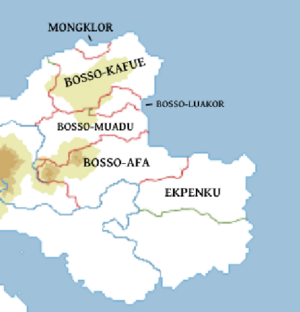Khobeh
Khobeh (Nyamu: Khɔbɛ̀), officially the Kingdom of Khobeh, is a country in eastern Nkungu, bordered by Afa to the south.
Kingdom of Khobeh Àgbà Khɔbɛ (Nyamu) | |
|---|---|
| Capital | Kashinkhor |
| Official languages | Nyamu |
| Recognised regional languages | Hlong Gara Nganka |
| Demonym(s) | Khobehi |
| Government | Elective constitutional monarchy |
• King (Mbolu) | Ndàkàri Jubùlà Kàṣi |
• Head of the Royal Assembly of Kashinkhor | Dada Kɔbuani |
| Legislature | Royal Assembly of Kashinkhor (Ndizu Kàṣiŋkhɔla) |
Etymology
The name Khobeh comes from the historical city Ŋkrɔ́bɛ̀ (modern-day Kashinkhor), meaning "central city" in Middle Bosso (from the words "ŋkrɔ́" (city; village) and "bɛ̀" (middle)), which became Khɔ́bɛ̀ in modern Nyamu.
History
Bosso Empire
(WIP)
Khobeh Confederation

Shortly after the collapse of the Bosso Empire in 2327 CY, four kingdoms arose from its former provinces, each of which were named after the dynasties of their ruling chiefs; the former province Alanku became Bosso-Kafue, the former province Ilafu became Bosso-Luakor, the former province Odo became Bosso-Muadu, the former province Eshinku became Bosso-Afa. The rulers of these four kingdoms each claimed to be the de jure successors of the Empire (hence the kingdoms' names starting with "Bosso"), and sought to reunite the former Bosso territories under their dynasty. The Hlong kingdom of Mongklor was also founded, but did not claim Bosso succession. Contention between the four Bosso kingdoms sparked a 5-year war, eventually ending in a stalemate.
After the war officially ended, the four kings involved appeared at the historic city of Khobeh (modern-day Kashinkhor) in 2535 CY to sign the Kàri-Jąkhą treaty, unifying the four nations as the Khobeh Confederation. The Confederation was successful until the same power struggles arose again, causing civil war between the regions and the secession of Bosso-Afa from the Confederation in 2677 CY. Warrior Bų̄̀lą̀ Akpàlamùą̀ Kàṣi overthrew the king of the Kafue region with the help of several clan leaders, eventually conquering the remaining Confederation and crowning himself king of a centralized Khobeh in 2727 CY.
Early Kingdom
Khobeh under Bų̄̀lą̀ Kàṣi (2727-2750 CY) marked a transformative era in the early history of the nation. Bų̄̀lą̀ Kàṣi brought about many reforms politically and culturally, most significant of which was the establishment of a new Sakhāndizų council resembling that of the Bosso Empire. This newer Sakhāndizų would evolve into the modern-day Royal Assembly. This council, like that of Bosso, was a bicameral council bringing together all the traditional clan leaders of the land with appointed officials. Unlike Bosso however, traditional clan rulers along with the dynastic rulers of the Confederation were put together in one body of the council, while the other consisted of 15 officials, all of which were traditional priests. Alongside the new political model was also reduced provincial autonomy, as the seperate militias of Confederation-era rulers were now conglomerated into a central Khobehi army under direct rule of Bų̄̀lą̀ Kàṣi. Bų̄̀lą̀ Kàṣi also promoted a restoration of Bosso culture in Khobeh, fostering a cultural movement known as Waga Agba ("to return and retrieve") which centered around revitalizing and modernizing past traditions. Despite the Nyamu centrism of the time period, Waga Agba also resonated with Hlong peoples as it called to traditions and customs present in both Nyamu and Hlong culture.
Involvement in Copper War
Tawalu Jukala
(WIP)
Kayabi Conflict
(WIP)
Politics
Government
Khobeh is an elective constitutional monarchy. The head of state is the king (mbolu), currently Mbolu Ndàkàri Jubùlà Kàṣi, who is appointed by the Royal Assembly of Kashinkhor. The king exercises executive authority in accordance with the Nkuna Gbu ("great law"). By the Nkuna Gbu, the Royal Assembly has the authority to repeal any decrees from and depose the current king.
Royal Assembly
The Royal Assembly of Kashinkhor (Ndizu Kàṣiŋkhɔla) is the bicameral legislative body of Khobeh. The Royal Assembly is composed of the Mbuyandizu, which consists of the four mbuya belonging to each of the four provinces of Khobeh, and the Ndizu-Gburu, which consists of 15 democratically elected officials. The Ndizu-Gburu was formerly a religious assembly of Aku Biakor clerics until [X date/event]. The Ndizu-Gburu elects one of the mbuya from the Mbuyandizu to be the head of the Royal Assembly.
Administrative divisions
Khobeh is divided into four provinces (aju), namely Kafue, Luakor, Muadu, and Jaara. The Kafue, Luakor, and Muadu provinces correlate with the historical Confederation kingdoms in both names and borders. The Jaara province was established in 2736 CY after Bų̄̀lą̀ Akpàlamùą̀ Kàṣi's conquest of land inhabited by the Jaara people in the west. The provinces of Khobeh are further divided into districts (mbinga, "border"), of which there are X overall. The districts of Khobeh are further divided into towns (ŋkhɔ). Each of Khobeh's provinces, except Jaara, are dually ruled by both a mbuya, who is elected by the Provincial Assembly of the respective region, and a mbolu-ajula, a hereditary king hailing from the individual dynasties of the Confederation. The Jaara province does not have a Provincial Assembly or a mbolu-ajula and is governed by a mbuya appointed by the Royal Assembly directly.
Foreign relations
Demographics
Ethnic groups
The Khobehi population include four main ethnic groups; the Nyamu being the largest, along with the Hlong, Gara, and Nganka. Jaara people (mixed Hlong-Gara minority inhabiting the northwestern areas of Khobeh) and smaller minorities of Dzuma immigrants from either Afa or Bomakwodor are also present.
Language
The official language of Khobeh is Nyamu, with minority languages such as Hlong and Gara being spoken in the northern regions and Nganka spoken in the southwestern regions. Bilingualism is prominent within urban areas in Khobeh, even among the Nyamu majority. The use of Bosso is also commonplace, though solely in religious context. Bosso is used as a general sacred language for all religions, including non-indigenous minority religions.
Religion
Aku Kwabolu is the most widely practiced religion in Khobeh, with Aku Biakor being the most widespread sect in the country. Aku Biakor has historically dominated the country for centuries, as many of Khobeh's former leaders were professed Aku Biakor adherents. The Kɔgɔ Ilā, the largest temple in the country and seat of the religious head (the Jų̄ Asìla) is in Kashinkhor. The Khobehi government formerly espoused Aku Biakor as a national sect in X CY, due to its popularity and the fact that much of the Royal Assembly also practiced Aku Biakor. After [some religious event], the Royal Assembly decided that the Khobehi government would not espouse any religion or sect. Aku Sakhakharun is the more popular sect in rural areas as what many rural Khobehis believe is a more authentic counterpart to Aku Biakor. Khobeh also has smaller minorities of other Aku Kwabolu sects dispersed throughout the nation, such as [insert sect here]. The non-Aku Kwabolu population is Khobeh is very small and consists of either non-Bosso ethnic diasporas (i.e Dzumas) or Khobehis who have converted to a religion not indigenous to the eastern Nkungu area.
Culture
Art
Music
The music of Khobeh primarily includes indigenous Nyamu music and distinguished modernized variants stemming from it, with some influences from the minority cultures of the nation. Khobeh has been well-known for its intricate musical traditions and forms, varying from melismatic acapella music to complex drumming cadences with improvised interpolations, which have largely influenced that of the rest of the eastern Nkungu area. How the average Khobehi enjoys music is largely dependent on class and area; rural Khobehi often enjoy music from traditional bards who play in village squares, while Khobehi in urban areas often go to dance halls (njanja) where bands play njanja music. Njanja music, however, does not have the same popularity among wealthier Khobehi people, many of which find the genre to be crude. Instead, many go to auditoriums or polished njanja wukha ('glass njanja') where bands play imported Hashdezi genres, or enjoy imported music at home from a gramophone.
The most prominent music of Khobeh and neighboring nations is giranyia, a genre focusing on the gira string instrument. Giranyia is named after the large orchestras of gira players (of the same name) who play this music in public areas. Historically, any music involving the gira was associated with rural life, but in the 4590s CY rural gira players began flocking to busy cities in large groups to play at njanjas. These groups eventually piqued the interest of former Mbolu Búlà Jufelàkalà Kàṣi, who sponsored them to play at auditoriums internationally. Due to these circumstances, giranyia is the only genre in Khobeh that enjoys equal popularity from both rural and urban life of all classes.

